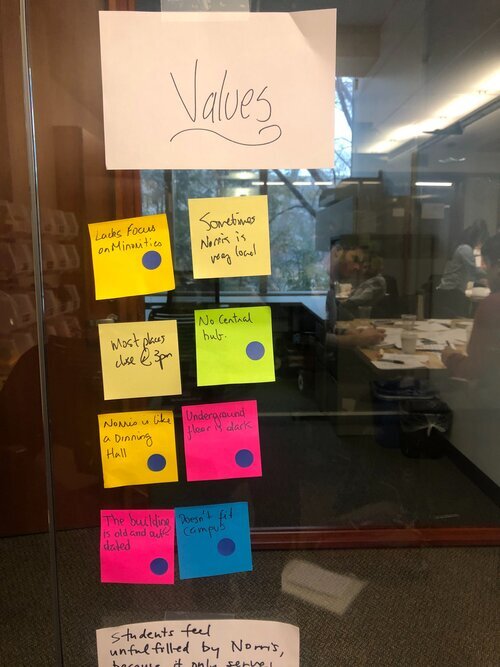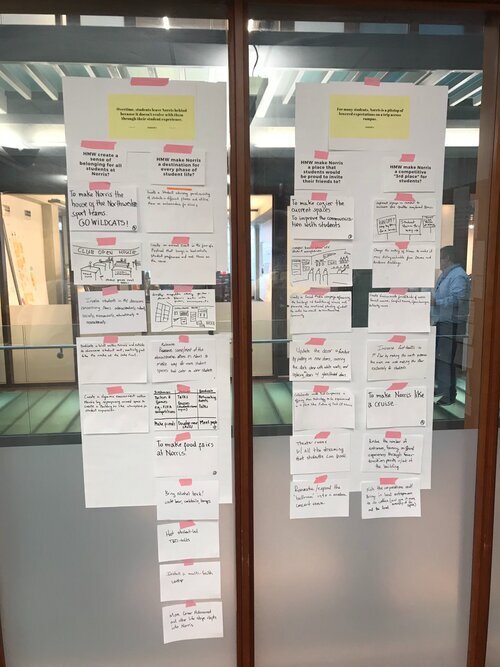Student Center at Northwestern University
Ethnographic Research // User Contextual Interviews // Personas // Lenses // Ideation // Storyboarding // Business Case
To solve a problem, you need to make sure it’s real and you need to tell a story.
As part of the mpd2 program at Northwestern University, my team was tasked with a problem: How might Norris provide a better experience for users?
Through research, analysis, creative problem solving, and visualization we tackled the problem over a month.
The Student Center is often called Norris after the student from which it is named.

Using A-E-I-O-U
To begin understanding the Student Center at Northwestern, our team employed a simple framework to gather and organize information using the vowels A, E, I, O & U.
Activities - What will we see people doing? What are the modes people work in and the specific activities and processes that people go through?
Environments - Where will we go to observe behaviors? What is the character and function of the space overall, and of individuals spaces or shared spaces?
Interactions - Who/what are the interactions we’ll observe? What is the nature of routine and special interactions between people, between people and objects in their environment, or across distances?
Objects - What things are people using? What are the objects and devices people have in their environments and how do they relate to their activities?
Users - Who will we observe? What are the roles and relationships? What are the values and perceptions?
Activities
Students being the majority of the people at Norris were observed eating, drinking, working, studying, playing, and organizing groups.
Environments
Though it was difficult to categorize and identify the environments within Norris, external and internal environments made it easier to describe the surroundings of the students.
Interactions
At Norris, there are so many interactions going on that we had to break them down into 1-person, 2-3 people, and 4+ people groups.
Objects
Most of the furniture in Norris seemed out of place and or out-of-order. Objects that people brought into Norris and disposables like newspapers were the other categories we used.
Users
Though undergraduate students became our primary user group the entire list of users included faculty, dining staff, continuing education, maintenance, office staff, student staff, and visitors.
Primary Research Time
Getting to know the users and people of the Student Center
After putting a framework to the initial basic research phase in the findings of the Student Center, our job was to further our research through personal immersion, user self-documentation, more observation, and contextual interviews.
Our team found observation and personal immersion to be our most useful methods of research. Contextual interviews and user self-documentation were impossible however because the Student Center administration required that we have permission to even speak to people for research.
Norris Ecosystem Map
Student Emotions
Student Worker Interview
More Student Interviews
Student Worker Interviews
Standout Quotes
In the Studio
Analysis Paralysis
Getting through the research means also seeing the data through lenses, synthesizing it and ideating from it.
We thought that research would be the most difficult part of this project.
We were wrong.
I am not sure we could put a number of hours on the work that we put in to analyzing the data, but it definitely took weeks (at least I think).
Through the use of Lenses like Values, Activities, and Modes of Behavior, we were able to categorize facts from our research. Then we turned those into Insights that were interesting, relevant, and actionable.
From our three insights, we developed “How Might We” sentences that reopened the funnel of the process that leads to ideation and creation.
The idea that our team found would address the problem the best was a bar called “Wild House” located in Norris that would improve the student experience by making it a place students could grow within their undergraduate careers.













Northwestern’s Wild House
To bring the Wild House to life, we storyboarded the solution to demonstrate how students grow with the bar and proving how the value is much greater than just a bar.
Charlie's Journey
Freshman orientation, introducing Norris, where Wild House is located.
Charlies has lots of options to eat and drink at Wild House.
Freshman corking ceremony that gets stored at Wild House.
Charlie gets a student job at Wild House in his 2nd year.
People of all ages come to eat and meet at Wild House.
Students can personalize Wild House with spaces like the Sophomore Wall.
Charlie and his friends go to Wild House for a drink in their 3rd year.
Charlie meets Sarah at the Mic Night Connection.
Charlie and Sarah’s relationship gets started because of Wild House
In year 4, Charlie cannot believe he has spent so much time at Wild House.
He loves watching sports at Wild House with his old friends and new.
Charlie & Sarah celebrate graduation at the Wild House graduation party!
Making the case.
Once we had a solution, the final piece was to make it concrete. This entailed making a business case for why the Wild House would be a successful solution and why it would improve the student experience at Norris.


























